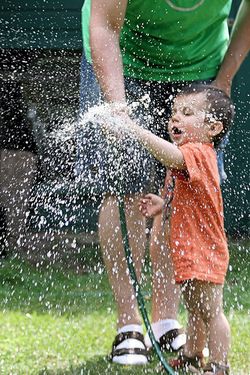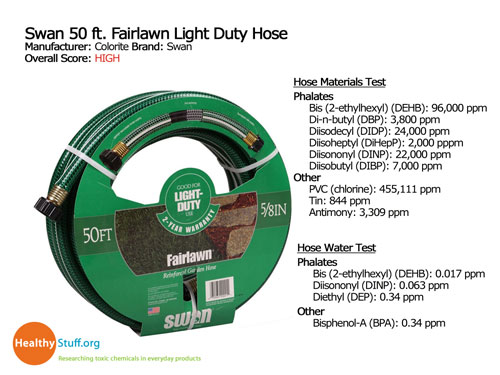A few years ago I started getting questions from gardeners and farmers about garden hoses. I grew up on a farm, and like most Americans, I garden, so I was curious to see if they contained any hazardous chemicals. We’ve been testing cars, car seats, toys and other children’s products for years, so we knew the drill.
So, for the first time in 2012 we tested both the hoses and the water that sat in a hose for a few days. Our test data showed that the plastic additives in PVC hoses, including phthalates and bisphenol A (BPA), leach out of the hose and into the water. When we lab tested the water, we found additives at levels many times higher than drinking water.
This week we screened more garden hoses and released new data that showed PVC hoses still contain phthalates that are banned in childrens’ products — and that they continue to leach phthalates and BPA at levels that exceed drinking water standards.
We learned some good news too.If you want a hose without heavy metals and toxic additives, there actually are a lot more on the market now. That’s great news, and it demonstrates that it’s possible to make a good hose without exposing people to more hazardous chemicals!
Highlights of Garden Hose Testing
- 21 new garden hoses were purchased from Lowes, The Home Depot, Walmart, Target and Kmart. One-third (8 of 21) of the garden hoses tested contained high levels of one or more chemicals of concern. These hoses are widely available and top selling brands.
- Of the 21 garden hoses tested, 67% (14 of 21) were polyvinyl chloride (PVC) and 4.5% contained brominated flame retardants.
- 5 hoses were tested for phthalate content. Total phthalate content in those hoses ranged from 11 to 18% by weight. Phthalates are not chemically bound to the material and can be released to the air and water.
- 100% of the PVC hoses tested for phthalates contained one or more of the phthalates which have been banned by CPSC in children’s products.
- Hazardous metals were also found in hoses; including organic tin stabilizers (29%); and antimony (52%);
- Overall the level of lead in garden hoses declined between 2012 and 2013. The percentage of hoses with greater then 100 ppm lead declined from 50% in 2012 to 14% in 2013.
Click here to find safer hoses and test results.
How did we get in this mess to begin with?
In part, we have a massive regulatory failure that needs to be fixed. But we also have a design problem. PVC is a very cheap material used in a wide array of consumer products. Every room in your house — not to mention your office, car and garden shed — contain PVC products. And while PVC is cheap, it doesn’t perform how we want it to without toxic additives that give it flexibility and color, UV and heat resistance, and many other properties.
Designing out the hazard?
Phthalates are a group of industrial chemicals that add flexibility and resilience to many consumer products. Phthalate plasticizers are not chemically bound to PVC, which is why they leach, migrate or evaporate into indoor air, foods, etc.
Many consumers don’t know that BPA is not just used in polycarbonate and epoxy resins. It’s also used as a co-stabilizer for certain PVC phthalate plasticizers (e.g., DIOP and DINP). Another common use of BPA is in outdoor vinyl products that are exposed to high UV.
The big disconnect
We are designing a product that is intended to carry water and using a plastic that requires – and is proven to leach – toxic additives into that water. The problem with PVC is that it’s brittle. If you want it to act like a rubber hose, you need to add more than 15% (by weight) of plasticizers to make it flexible. You also have to add BPA to stabilize the plasticizers to use them in outdoor products that are exposed to UV light. That’s how you end up with garden hoses that leach banned phthalate plasticizers’ and BPA into the water they carry.
This is just one example and, unfortunately, there’s no shortage of bad design in consumer products. So, what is a consumer to do?
One new retailer initiative offers real hope
A new campaign called Mind the Store is asking retailers to take a closer look at what’s on their shelves to then develop a plan to reduce the use of problematic chemicals. If retailers don’t insist on good design from suppliers, then by default it is a bad design. How nice would it be to know that the garden hose you bought from Target, Walmart, Home Depot or Lowes does not contain hazardous chemicals?
And, if we’ve banned these chemicals in childrens’ products, then why are we allowing companies to dump them into other products? Real leadership from retailers could have a huge impact on what is available to customers. If retailers invest in well-designed, healthier and safer products, we will be so much closer to witnessing the sea change in manufacturing practices that we so badly need.
We might even be able to drink from our hose again.





